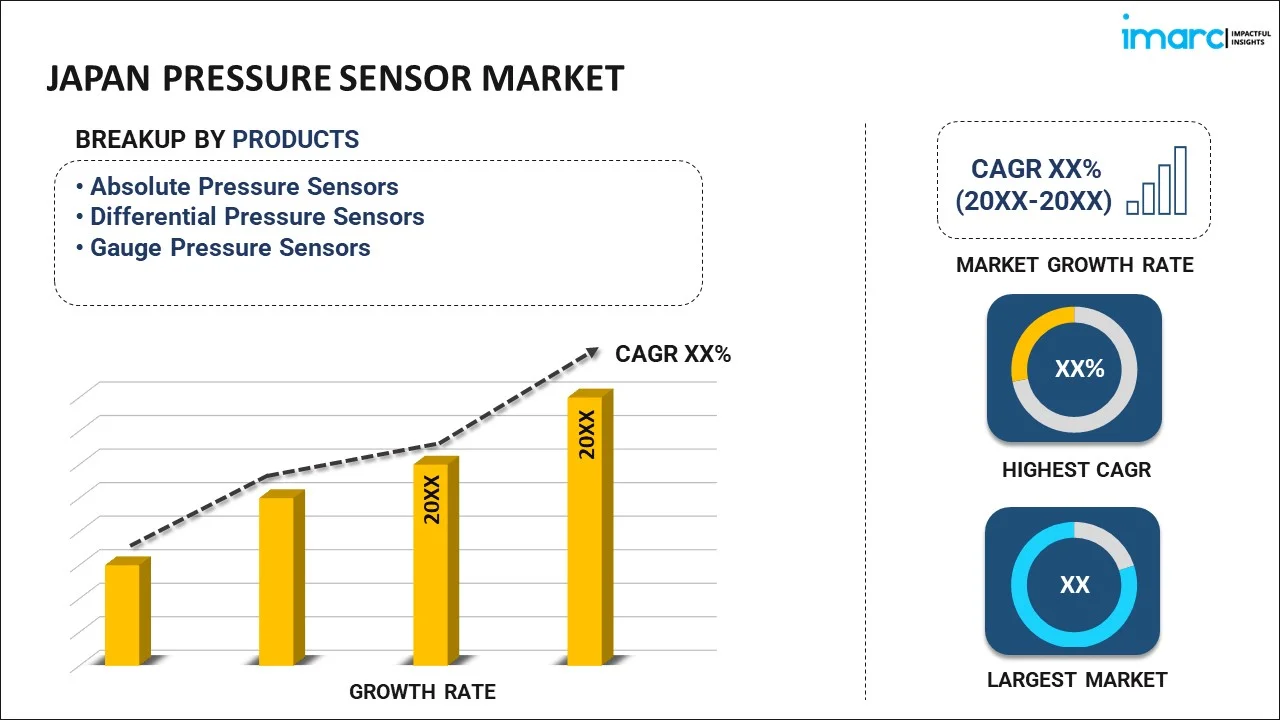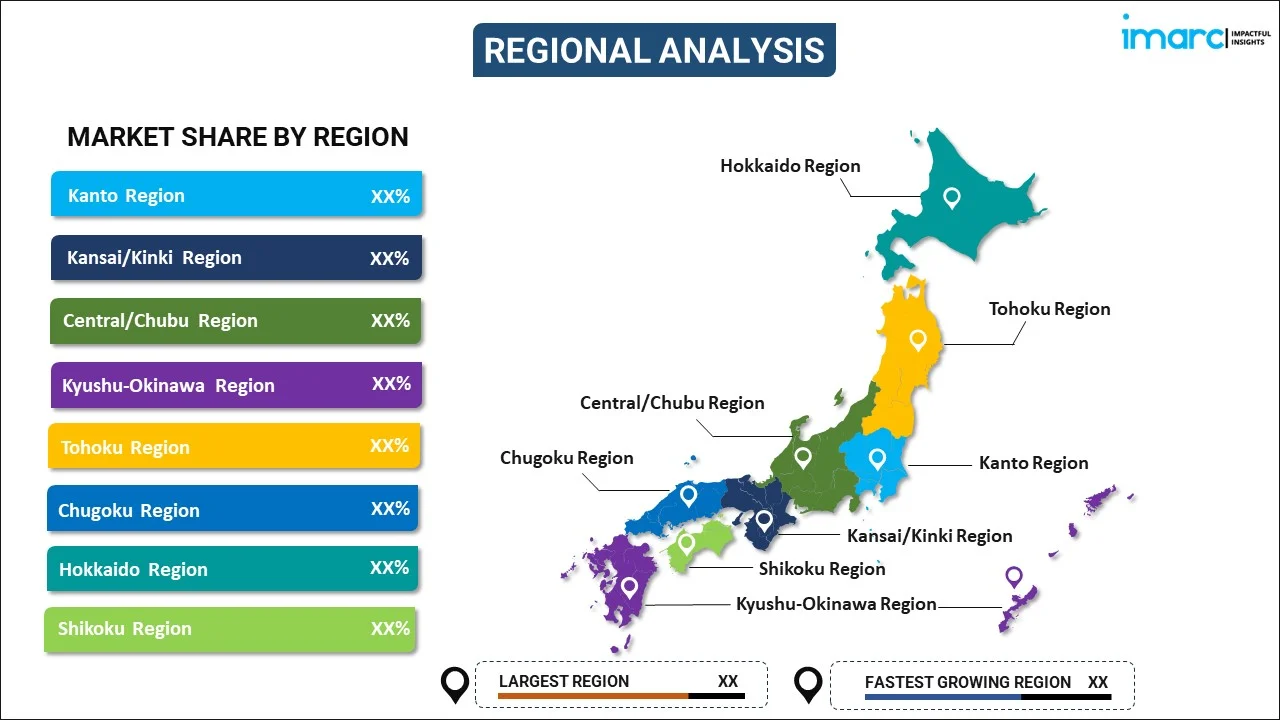
Japan Pressure Sensor Market Report by Product (Absolute Pressure Sensors, Differential Pressure Sensors, Gauge Pressure Sensors), Type (Wired, Wireless), Technology (Piezoresistive, Electromagnetic, Capacitive, Resonant Solid-State, Optical, and Others), Application (Automotive, Oil and Gas, Electronics, Medical, Industrial, and Others), and Region 2025-2033
Market Overview:
Japan pressure sensor market size reached USD 1.1 Billion in 2024. Looking forward, IMARC Group expects the market to reach USD 2.5 Billion by 2033, exhibiting a growth rate (CAGR) of 8.4% during 2025-2033. The increasing utilization of emerging technologies like the Internet of Things (IoT), wearable devices, and smart home automation systems that enhances the demand for pressure sensors to enable more precise and data-driven control, is driving the market.
|
Report Attribute
|
Key Statistics
|
|---|---|
|
Base Year
|
2024
|
|
Forecast Years
|
2025-2033
|
|
Historical Years
|
2019-2024
|
|
Market Size in 2024
|
USD 1.1 Billion |
|
Market Forecast in 2033
|
USD 2.5 Billion |
| Market Growth Rate 2025-2033 | 8.4% |
A pressure sensor is a specialized device designed to measure and detect changes in pressure within a given environment or system. It operates by converting the applied pressure into an electrical signal, which can then be interpreted and utilized for various purposes. Pressure sensors find wide-ranging applications across industries, including automotive, aerospace, medical, and industrial sectors. These sensors can be categorized into various types, such as piezoelectric, capacitive, and resistive sensors, each with their unique mechanism for pressure detection. Piezoelectric sensors generate voltage in response to pressure changes, while capacitive sensors rely on changes in capacitance, and resistive sensors alter their electrical resistance when subjected to pressure. Pressure sensors play a crucial role in monitoring and controlling processes, ensuring safety, and enhancing efficiency. They are used in applications like tire pressure monitoring systems, medical devices, HVAC systems, and industrial automation. The data collected from pressure sensors helps maintain optimal conditions, prevent equipment failures, and improve overall system performance, making them essential components in modern technology and engineering.
Japan Pressure Sensor Market Trends:
The pressure sensor market in Japan is experiencing robust growth, primarily due to several key drivers that are propelling its expansion. To begin with, the rapid advancement of technology has played a pivotal role in fostering innovation in pressure sensor design and functionality. Consequently, this has led to the development of more accurate and reliable sensors, which find applications in a wide array of industries. Furthermore, the increasing demand for pressure sensors can be attributed to the growing emphasis on automation and smart manufacturing. As industries strive for greater efficiency and productivity, the integration of pressure sensors into automated systems has become indispensable. In addition to this, the burgeoning automotive sector is a significant driver, with pressure sensors being integral components in modern vehicles for applications such as tire pressure monitoring and engine control. Moreover, environmental concerns and regulatory requirements, which have spurred the adoption of pressure sensors in various applications, particularly in monitoring and managing air and water quality, are expected to drive the market in Japan during the forecast period.
Japan Pressure Sensor Market Segmentation:
IMARC Group provides an analysis of the key trends in each segment of the market, along with forecasts at the country level for 2025-2033. Our report has categorized the market based on product, type, technology, and application.
Product Insights:

- Absolute Pressure Sensors
- Differential Pressure Sensors
- Gauge Pressure Sensors
The report has provided a detailed breakup and analysis of the market based on the product. This includes absolute pressure sensors, differential pressure sensors, and gauge pressure sensors.
Type Insights:
- Wired
- Wireless
A detailed breakup and analysis of the market based on the type have also been provided in the report. This includes wired and wireless.
Technology Insights:
- Piezoresistive
- Electromagnetic
- Capacitive
- Resonant Solid-State
- Optical
- Others
The report has provided a detailed breakup and analysis of the market based on the technology. This includes piezoresistive, electromagnetic, capacitive, resonant solid-state, optical, and others.
Application Insights:
- Automotive
- Oil and Gas
- Electronics
- Medical
- Industrial
- Others
A detailed breakup and analysis of the market based on the application have also been provided in the report. This includes automotive, oil and gas, electronics, medical, industrial, and others.
Regional Insights:

- Kanto Region
- Kansai/Kinki Region
- Central/ Chubu Region
- Kyushu-Okinawa Region
- Tohoku Region
- Chugoku Region
- Hokkaido Region
- Shikoku Region
The report has also provided a comprehensive analysis of all the major regional markets, which include Kanto Region, Kansai/Kinki Region, Central/ Chubu Region, Kyushu-Okinawa Region, Tohoku Region, Chugoku Region, Hokkaido Region, and Shikoku Region.
Competitive Landscape:
The market research report has also provided a comprehensive analysis of the competitive landscape in the market. Competitive analysis such as market structure, key player positioning, top winning strategies, competitive dashboard, and company evaluation quadrant has been covered in the report. Also, detailed profiles of all major companies have been provided. Some of the key players include:
- Honeywell International Inc.
- Infineon Technologies AG
- Kistler Group
- NXP Semiconductors N.V
(Please note that this is only a partial list of the key players, and the complete list is provided in the report.)
Japan Pressure Sensor Market Report Coverage:
| Report Features | Details |
|---|---|
| Base Year of the Analysis | 2024 |
| Historical Period | 2019-2024 |
| Forecast Period | 2025-2033 |
| Units | Billion USD |
| Scope of the Report | Exploration of Historical and Forecast Trends, Industry Catalysts and Challenges, Segment-Wise Historical and Predictive Market Assessment:
|
| Products Covered | Absolute Pressure Sensors, Differential Pressure Sensors, Gauge Pressure Sensors |
| Types Covered | Wired, Wireless |
| Technologies Covered | Piezoresistive, Electromagnetic, Capacitive, Resonant Solid-State, Optical, Others |
| Applications Covered | Automotive, Oil and Gas, Electronics, Medical, Industrial, Others |
| Regions Covered | Kanto Region, Kansai/Kinki Region, Central/ Chubu Region, Kyushu-Okinawa Region, Tohoku Region, Chugoku Region, Hokkaido Region, Shikoku Region |
| Companies Covered | Honeywell International Inc., Infineon Technologies AG, Kistler Group, NXP Semiconductors N.V, etc. |
| Customization Scope | 10% Free Customization |
| Post-Sale Analyst Support | 10-12 Weeks |
| Delivery Format | PDF and Excel through Email (We can also provide the editable version of the report in PPT/Word format on special request) |
Key Questions Answered in This Report:
- How has the Japan pressure sensor market performed so far and how will it perform in the coming years?
- What has been the impact of COVID-19 on the Japan pressure sensor market?
- What is the breakup of the Japan pressure sensor market on the basis of product?
- What is the breakup of the Japan pressure sensor market on the basis of type?
- What is the breakup of the Japan pressure sensor market on the basis of technology?
- What is the breakup of the Japan pressure sensor market on the basis of application?
- What are the various stages in the value chain of the Japan pressure sensor market?
- What are the key driving factors and challenges in the Japan pressure sensor?
- What is the structure of the Japan pressure sensor market and who are the key players?
- What is the degree of competition in the Japan pressure sensor market?
Key Benefits for Stakeholders:
- IMARC’s industry report offers a comprehensive quantitative analysis of various market segments, historical and current market trends, market forecasts, and dynamics of the Japan pressure sensor market from 2019-2033.
- The research report provides the latest information on the market drivers, challenges, and opportunities in the Japan pressure sensor market.
- Porter's five forces analysis assist stakeholders in assessing the impact of new entrants, competitive rivalry, supplier power, buyer power, and the threat of substitution. It helps stakeholders to analyze the level of competition within the Japan pressure sensor industry and its attractiveness.
- Competitive landscape allows stakeholders to understand their competitive environment and provides an insight into the current positions of key players in the market.
Need more help?
- Speak to our experienced analysts for insights on the current market scenarios.
- Include additional segments and countries to customize the report as per your requirement.
- Gain an unparalleled competitive advantage in your domain by understanding how to utilize the report and positively impacting your operations and revenue.
- For further assistance, please connect with our analysts.
 Inquire Before Buying
Inquire Before Buying
 Speak to an Analyst
Speak to an Analyst
 Request Brochure
Request Brochure
 Request Customization
Request Customization




.webp)




.webp)












